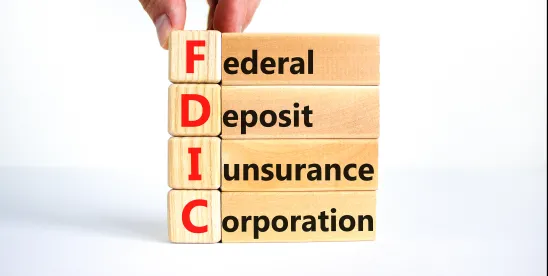On July 30, 2024, the Federal Deposit Insurance Corporation (“FDIC”) issued a notice of proposed rulemaking to amend its brokered deposit regulations (the “Proposed Rule”). The Proposed Rule is subject to a 60-day public comment period after it is published in the Federal Register. If finalized, the Proposed Rule would effectively undo the regulatory changes promulgated by the FDIC in December 2020 under Chairwoman Jelena McWilliams (the “2020 Rule”). The 2020 Rule loosened the definition of “deposit broker” and expanded the exceptions to the definition, thereby resulting in fewer deposits being classified as brokered deposits. However, the Proposed Rule would not only reverse the liberalization of the 2020 Rule—it would also codify certain concepts which, prior to the 2020 Rule, only existed within FDIC guidance (such as FDIC FAQs and Advisory Opinions), arguably creating a stricter brokered deposit regime than existed prior to the 2020 Rule.
What does the Proposed Rule say?
Among other things, the Proposed Rule would:
- Broaden the “deposit broker” definition, including to now encompass third parties that propose or determine deposit allocations at one or more banks (including through the use of an algorithm or similar program or technology), as well as third parties that receive fees from banks or customers in exchange for placing deposits
- Eliminate the “exclusive deposit placement arrangement” exception, which currently provides an exception for third parties that only place deposits with one bank
- Eliminate the “enabling transactions” primary purpose exception, which currently provides an exception for third parties that, with respect to a particular business line, place 100% of depositors’ funds into transactional accounts that do not pay any fees, interest or other remuneration to the depositor
- Narrow the “25% test” primary purpose exception, which currently provides an exception to third parties that, with respect to a particular business line, place less than 25% of their customers’ assets under administration with banks, to only apply to broker-dealers and investment advisers, to reduce the 25% limit to 10%, and to require that the deposits be placed into non-maturity accounts
- Amend the general primary purpose exception to, among other things, consider the third party’s intent in placing customer funds and whether that intent is for a substantial purpose other than to provide a deposit-placement service or FDIC deposit insurance
- Update the notice and application processes to the primary purpose exception and only allow banks (and not third parties) to file the notices and applications
- Clarify how a bank that loses its “agent institution” status regains that status for purposes of the limited exception for reciprocal deposits
Why did the FDIC issue the Proposed Rule, and does its justification pass muster?
The FDIC’s stated concerns are that the adoption of the 2020 Rule has led certain deposit arrangements to no longer being classified as brokered, even though “the FDIC believes such deposits present similar risks as brokered deposits and could pose serious consequences for [insured depository institutions (“IDIs”)] and the DIF.” The FDIC also states that entities misunderstand and inconsistently interpret the 2020 Rule and, therefore, misreport (i.e., underreport) brokered deposits.
As justification for the stricter regime that would be established under the Proposed Rule, the FDIC states that its “statistical analyses and other studies have found that an IDI’s use of brokered deposits in general is correlated with a higher probability of failure and higher losses to the DIF upon failure” (emphasis added). The “statistical analyses and other studies” that the FDIC refers to are its 2011 study on core deposits, with data updated through 2017—predating the 2020 Rule by three years and the Proposed Rule by almost seven years. Use of stale data may be more justifiable when the data has consistently shown a direct causal link, but the old adage of “correlation does not imply causation” comes to mind here.
The FDIC also points to the failures of First Republic Bank and Voyager as further justification for certain aspects of the Proposed Rule, yet glosses over the fact that high levels of uninsured deposits and deposit concentrations were also at play there and disregards data from the 2023 bank failures that proved brokered deposits to be the least volatile when banks suffered a liquidity crisis.
With the Proposed Rule, the FDIC continues to use brokered deposits as a proxy for distinct areas of risk—including imprudent asset growth, liquidity risk (e.g., uninsured deposit levels, concentrations and competitors’ pricing) and third party risk management—which should instead be evaluated and addressed on a separate and tailored basis. There is also no acknowledgement that, in a world where large withdrawals can be made with the click of a button, deposits obtained directly from customers (i.e., “core deposits”) can be, and often are, just as “hot” as deposits obtained through a third party intermediary. In fact, the presence of a third party in a deposit placement arrangement can often make such funds “stickier” than they otherwise would be and thus prevent or delay a significant outflow, especially if the bank has negotiated strong contractual protections. Further, there is no apparent explanation or support offered for the proposition that the intent of the third party affects the underlying stability of the deposits.
What are the implications of the Proposed Rule?
More deposits will be classified as “brokered deposits”
Under the Proposed Rule, more third parties will qualify as “deposit brokers,” and fewer third parties will qualify for the exceptions to the “deposit broker” definition. Any third party intermediary that is involved in placing deposits will, in effect, be presumed to be a “deposit broker.” As a result, a larger percentage of deposits will be deemed brokered deposits. In fact, it is difficult to imagine many examples of third party deposits that will not be considered to be brokered under the Proposed Rule (especially with the new “deposit broker” definition now encompassing any person that receives a fee or other remuneration in exchange for the placement of deposits).
Although the brokered deposit restrictions technically only apply to banks that are less than well capitalized (including banks that are subject to a consent order with a capital requirement), examiners review all banks’ brokered deposit levels and scrutinize banks with higher levels of such deposits. Additionally, all banks are required to accurately report brokered deposit levels on their Call Reports, and brokered deposit levels also impact FDIC assessment amounts. Perhaps most importantly, examiners evaluate the liquidity CAMELS component partly in light of overall wholesale funding levels, including brokered deposits. As part of the analysis, examiners also require banks to assume that they are subject to prompt corrective action, and thus limits on brokered deposits. As a result, a broader basket of brokered deposit levels may result in lower liquidity ratings. Because AOCI is still elevated across the industry, there may be a spillover effect on the interest rate sensitivity rating (and even on the management rating).
Because more deposits will fall into the brokered deposit bucket from the get-go, banks will need to expend more time, funds and effort to attempt to qualify for exceptions to the “deposit broker” definition. Such exceptions will, in turn, be more difficult to satisfy and will be subject to more onerous notice and application processes. The new “primary purpose exception” definition under the Proposed Rule, and the new factors that the FDIC will consider in evaluating an application thereunder, are inherently subjective and will provide the FDIC with wide latitude to disfavor any deposits that it views as risky. Moreover, a third party will no longer be permitted to file a notice or application that all of its partner banks can rely upon; rather, each partner bank would need to file its own separate notice or application.
There will be a chilling effect on bank-fintech partnerships
Because most deposits sourced through fintech partners will now be considered brokered deposits, fintech partnerships will be less attractive to banks. For the reasons discussed above, fintechs will face an uphill battle in arguing that they are not deposit brokers.
So-called “fintech aggregators,” “fintech intermediaries” and “embedded finance platforms” should also take note of the Proposed Rule. In our experience, companies that provide technology or administrative services to fintechs and BaaS banks are often surprised to learn that they, too, may be considered “deposit brokers.” Such companies and our bank clients are also often surprised to learn that each third party involved in a deposit placement arrangement must be analyzed under the brokered deposit rules, even if one of the third parties (like a fintech or broker-dealer) qualifies for an exception. In the preamble to the Proposed Rule, the FDIC discusses the bankruptcy of Synapse Financial Technologies, Inc. (“Synapse”), which the FDIC refers to as a fintech “middleware” company, and expressly states that Synapse “was a deposit broker that facilitated the placement of customer deposits for various fintech companies looking for banking services with IDIs” (emphasis added). This appears to be the first time the FDIC has publicly characterized a fintech aggregator as a “deposit broker” under the existing brokered deposit rules. Such characterizations would be even easier to validate under the Proposed Rule.
The Proposed Rule could create safety and soundness concerns and have other unintended consequences
As Vice Chairman Travis Hill noted in his statement on the Proposed Rule, “[t]he term ‘brokered deposits’ encompasses many different types of deposits with very different characteristics and risks.” To continue to arbitrarily place these varied and nuanced arrangements into one ever-expanding bucket could, ironically, decrease the safety and soundness of banks by restricting their access to certain funding sources that are actually, in practice, less volatile than many of those that fall in the ever-shrinking “core deposit” bucket.
Vice Chairman Hill believes the Proposed Rule is a poor use of the FDIC’s time and resources. It may be a poor use of banks’ time and resources, as well. Community banks, especially, must make tradeoffs every day, and shifting focus away from concrete risks to an issue that is, at best, “generally correlated” to those risks, does not seem like a prudent use of such banks’ limited resources. Time and money spent analyzing deposit relationships under the Proposed Rule and preparing numerous primary purpose exception applications may be better spent enhancing liquidity and third-party risk management practices and focusing on overall funding mix from a holistic perspective. Otherwise, banks risk missing the forest for the trees.
Simultaneously, the Proposed Rule could negatively impact underbanked consumers’ access to financial services by disincentivizing banks from pursuing funding sources that enable them to meet the needs of such individuals, including through the bank-fintech partnerships discussed above.
What is the bigger picture here?
The Proposed Rule comes on the heels of several related regulatory actions, including:
- A joint statement by the FDIC, Federal Reserve and OCC regarding bank arrangements with third parties to deliver deposit products, released on July 25, 2024
- An interagency request for information by the FDIC, Federal Reserve and OCC on bank-fintech arrangements involving banking products and services distributed to consumers and businesses, released on July 25, 2024
- An FDIC request for information seeking input on the characteristics that affect the stability and franchise value of different types of deposits, released on July 30, 2024
It is a bit puzzling why the FDIC would release the Proposed Rule on the same day it sought input from banks relating to deposit stability, but it is consistent with the general “tread lightly” messaging that the regulators have been sending to banks in the BaaS and fintech partnership space.
With the release occurring four years after the 2020 Rule, it is hard not to feel like the Proposed Rule (as well as other rules proposed on the same day) are not part of an overall game of political boomerang. However, a rulemaking this late in the election cycle could be vulnerable to reversal or challenge depending on the results of the election, through the Congressional Review Act legislative process. Separately, the Proposed Rule could be susceptible to a judicial challenge under the Administrative Procedure Act in a world where courts no longer automatically defer to administrative agencies.
There are valid reasons to wonder if the brokered deposit rules, in any of their historical iterations, are the appropriate remedy for the risks they are meant to address. Such rules cannot be altered in any meaningful way without Congressional action, as the FDIC is handcuffed to the statutory language enacted in 1989. There have previously been Congressional attempts to directly regulate the risks allegedly tied to brokered deposits, such as the Asset Growth Restriction Act proposed by Senator Jerry Moran. Both Former Chairwoman McWilliams and Vice Chairman Hill have expressed support for replacing the brokered deposits restrictions with a growth cap for troubled banks. It remains to be seen what it will take for Congress to seriously consider taking action in this arena, but perhaps the Proposed Rule will provide the needed push.
What should my bank be doing?
Banks should start by determining the Proposed Rule’s effect on their brokered deposit volume. We expect that most banks would need to reclassify at least some of their deposits as brokered as a result of the Proposed Rule.
Banks that would be significantly impacted by the Proposed Rule should consider making their voice heard during the comment process. The comments will play an important role if the Proposed Rule is finalized substantially as written and is subsequently challenged.
A bank that would need to reclassify a significant amount of deposits as brokered under the Proposed Rule would be left to assess the impact on its liquidity in a relatively subjective manner. Accordingly, banks that want to take a proactive approach should begin conversations with their examiners as soon as practicable to understand how they may react to an increase in the bank’s brokered deposit volume resulting from the Proposed Rule. Banks should also consider restructuring existing contracts to enhance arguments for the narrower exceptions that would remain under the Proposed Rule assuming it is finalized as written.






 />i
/>i
